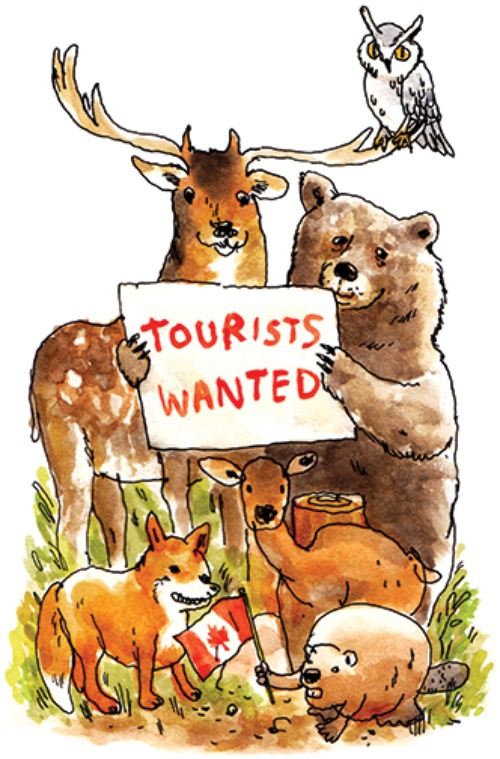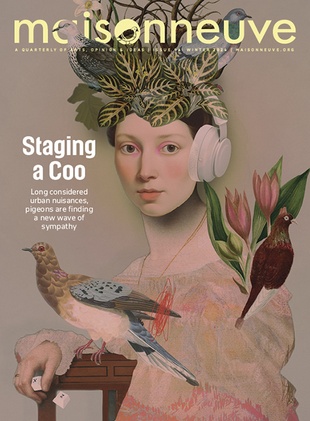 Illustration by Victor Kerlow.
Illustration by Victor Kerlow.
Nature vs. Numbers
With government cuts looming, Parks Canada needs cash. Are the guardians of our unspoiled wilderness selling out?
SNOW-CAPPED PEAKS, sturdy pine, the smooth descent of glaciers from mountaintop to turquoise pool; their views belong on stamps, postcards, money. Of all the conservation areas stretching across Canada’s vast and unruly terrain, the twin parks on the edge of the Rockies are emblems of the wilderness Canadians see as a defining national trait. They even sound good together: Banff and Jasper.
Right now, a glass-floored walkway is being bored into the side of a mountain along the Icefields Parkway, a highway that runs between the two parks. The walkway hangs over the edge of a canyon, stretching over waterfalls and along Tangle Ridge, 918 feet above the Sunwapta Valley. The company building it, Brewster Travel Canada, touts it as a “front-row seat to nature’s grand performance.”
Mike McIvor, president of the region’s Bow Valley Naturalists, calls it “the jockstrap.”
The Glacier Skywalk exemplifies the high emotions and financial strain facing Parks Canada, whose budget will be cut by $29.2 million by the 2014–2015 fiscal year. Through the winter of 2013, the agency conducted surveys on a proposal to increase entrance fees. About 1,600 employees are due to lose their jobs.
As a result, Parks Canada has turned to novel, and controversial, ways of ensuring that people don’t just visit our national parks—they stay and spend.
DESPITE POPULAR MYTH, Canada has not always cherished its wilderness: the Victorian writer Anna Jameson quipped that “a Canadian settler hates a tree.” But around the turn of the twentieth century, as cities grew denser and dirtier and the automobile became ubiquitous, country vacations emerged as a great Canadian past time.
Before long came the Group of Seven—a group of painters working between the 1920s and 1930s who gave us altars of the sublime, rough, and untouched Canadian landscape. The national parks were ready to cash in.
In 1885, the foundation of Canada’s national parks system was laid along the Alberta-B.C. border, in the thick of the Rocky Mountains. What would eventually become the Mountain Parks were first controlled and marketed by the Canadian Pacific and the Grand Trunk Pacific railway corporations as scenic stopovers along their westward lines. The drive behind the area’s eventual preservation was sparked when railway workers stumbled on hot springs in what are now the Banff, Jasper and Kootenay parks. The hot springs were, and are, a wonder—a place where visitors can go in the dead of winter to sit in swimsuits below snow-capped mountains. It wasn’t until 1918 that the parks were brought under government control.
These parks are now largely thought of—and taken for granted—as emblems of Canada’s unspoiled wild. But there’s a quote engraved on a brass plaque outside the old train station hotel in downtown Calgary that serves as a reminder that the parks system wasn’t exactly built on natural stewardship. “If we can’t export the scenery, we’ll import the tourists,” it reads, a motto written by W. C. Van Horne, one-time president of the Canadian Pacific Railway.
Today, his legacy is alive and well. Canada’s parks now span 300,000 square kilometres, just under 3 percent of our total landmass. Between 2008 and 2009, Parks Canada contributed $2.98 billion to the Canadian GDP. Visitor spending accounts for 81 percent of that. But if Van Horne represents the parks’ commercial spirit, another initialed Edwardian gent stands for its antithesis: J.B. Harkin.
The first commissioner of the parks branch in the Ministry of the Interior, Harkin was a government man interested in the divine emotions evoked by the wild. “What is needed in Canada today is an informed public opinion which will voice an indignant protest against any vulgarization of the beauty of our national parks or any invasion of their sanctity,” he once wrote.
The history of Canada’s national parks is a century-old struggle between the visions of Harkin and Van Horne. Brewster Travel Canada—the company now building the Skywalk— has been at the heart of this dilemma almost from the beginning.
Outfitter Fred Brewster had one of the first private businesses to benefit from the commercialization of Canada’s national parks, guiding guests on fishing trips around Banff starting in 1892. By 1928, he had perfected a three-day excursion to Maligne Lake using brand-new overland coaches.
Brewster’s offerings have grown more sophisticated over the years. Now, the company picks up tourists at the airport and shuttles them to idyllic mountain towns, arranging for boat tours and loading groups of people onto large buses to drop them off at the top of mountains and take in the scenic vistas. A round-trip on the Brewster gondola, a closed-in ski lift that climbs more than 2000 feet and takes you to the top of Sulphur Mountain in Banff, will cost you $34.95. A trip to the Columbia Icefield on a Brewster bus along the Icefields Parkway will cost you $49.95.
THE ICEFIELDS PARKWAY is a 232 kilometre highway connecting Banff and Jasper National Parks. Built in 1940, it features stunning views of glaciers, mountains and wildlife like mountain goats and grizzly bears. Beautiful though it is, people tend to cruise through, taking in the scenery from their minivan windows. Parks Canada wants visitors to get out of their cars and stay awhile.
Enter Brewster’s Glacier Skywalk, that glass-bottomed platform in the mountainside. Some fear the attraction would set a precedent for developing national parks to the detriment of their natural splendor. After the Skywalk proposal went public in 2012, a campaign called “No Glacier Skywalk” collected 181,000 signatures for an online petition against the project. The group’s slogan: “Paradise paved is paradise lost.”
The Skywalk, which will loom over the canyon, has been called a high threat to nature by researchers at the University of Alberta. In a report they delivered to UNESCO, they say the Skywalk disturbs natural landscapes. According to the report, mountain goat populations will be displaced by the destruction of the mountainside. It also says that the Skywalk sets a dangerous precedent for allowing economic development to surpass ecological preservation. (The Skywalk has passed environmental impact assessments, though opponents say these assessments were inadequate.)
But while the Skywalk does involve physically disturbing the nature surrounding it, there’s also a certain irony in insisting that our parks remain unspoiled along a stretch that has already been bisected by a famous highway. “Some folks are just philosophically opposed to any type of development or infrastructure in a national park,” says Michael Hannan, Brewster’s president.
Mike McIvor, the naturalist, is one of these people. “These things are considered attractions but I consider them distractions,” he said. “It’s a magnificent place. It doesn’t need the bells and whistles.” McIvor and his wife, Diane, live in the town of Banff and are an inevitable presence at meetings about the future of the park. “I’ve been to far more than any sane person would, over the decades,” he says.
But park stalwarts like the McIvors are a dying breed. The country’s demography is changing—about 80 percent of the population lives in urban areas, compared to 62 percent in 1951. According to a report from Parks Canada, which surveyed people living in Toronto, Montreal and Vancouver, 60 percent of Torontonians say they’re not interested in camping, and 66 percent of respondents from Vancouver said it was too expensive to get to parks. 76 percent of respondents in all cities said they simply had a desire to travel elsewhere on vacations. It may be that Canada’s romance with the great outdoors is drawing to a close.
Brewster’s developments, of which the Skywalk is just one, showcase the tenuous balance between maintaining pristine parks and bringing in visitors, especially ones increasingly reluctant to brave the untamed wild. And the Brewster projects are far from the only partnerships with private companies aimed at popularizing the national parks.
A recent $13.8 million renovation of the Cave and Basin Historic Site hot springs allows private businesses to operate within the park. Miette, Radium and Banff, the same hot springs that were so integral to the formation of the parks in the nineteeth century, will soon be privatized, too. Parks Canada claims that hot springs attendance is low, though Banff Upper Hot Springs attracts about 350,000 people per year, Radium about 270,000, and Miette, 130,000.
“Running basically a spa experience and expending resources on it means we’re not concentrating on things a bit closer to our mandate,” says Tracy Thiessen, executive director of the Mountain National Parks at Parks Canada. (Talk to anyone with a stake in our national parks and, like a mantra, they’ll return again and again to “the mandate”: an uneasy combination of conservation, visitor experience and education enshrined in the Parks Canada Act.) “We’re not necessarily charging enough money to recapitalize … they can play with price elasticity and we can’t.”
By “price elasticity,” Thiessen of course means higher fees. Park advocates are worried that a private company would boost the price of admission beyond what’s affordable for most visitors. Right now, a family of four can visit the hot springs for under $30.
“It’s ironic,” says Eddie Kennedy, national executive vice president of the Union of National Employees, which represents Parks workers across the country. “If they’re willing to put [the hot springs] on the chopping block, they’ll put anything out there. That should be sacred ground.”
In fact, the hot springs are sacred ground for the nearby Stoney and Shuswap First Nations. Canada’s First Nations populations were victims of the push to develop parkland, and the development of most parks involved forceful eviction from their territory. The hot springs privatization process is currently stalled at the First Nations consultation level.
Beyond gussying up the hot springs, shills to park novices abound: in 2012 Parks introduced “learn to camp” programs and the “Xplorers” program, which hands out collectible badges for every park you go camping in. They’ve developed a new, park-customized clothing line and are paying just under $400,000 over two years to Toronto consulting firm Veritas to help re-imagine their brand. Last year, standing in line for the Banff Mountain Film Festival in Toronto, I was greeted by “Parka,” the agency’s new beaver mascot, who gave me a lanyard.
Back in Banff, a via ferrata (“iron road”) is being built into the side of Mount Norquay, stitching together a series of bridges, ladders and cables for amateurs so that they can seek the same thrills as seasoned climbers. A ban on hang-gliding is on the verge of being lifted. In New Brunswick, you can mountain bike through Fundy National Park, and you can stay in Parks Canada’s new “oTENTiks” almost anywhere—those are a cross between cabins and tents for inexperienced campers who don’t want to sleep on the ground. More and more parks across the country are welcoming RVs and camper trailers to campgrounds that were once tent-only.
The implication, of course, is that tourists are now more interested in ease of access and activity than perfectly conserved wilderness. Halifax professor and author Claire Campbell chalks this up to the parks’ “corporate-style management philosophy.”
It also happens to be true.
Canadians may like to think of ourselves as rugged outdoorsmen, but that’s just not the reality anymore. “If people don’t fall in love with nature, they’re not going to want to protect it,” says Parks’ Andrew Campbell. “The best way to protect it is by having those people in nature. It’s very symbiotic and that’s how we’re trying to look at it.”
This is the root of the national parks paradox. Standing anywhere within a national park, alone, is a profound experience. We almost never get a chance to interact with nature on nature’s terms, which is what a national park has promised us. It’s the untouched that draws us there in the first place, after all. But is an untouched wilderness, secreted away and unvisited, worthwhile?





